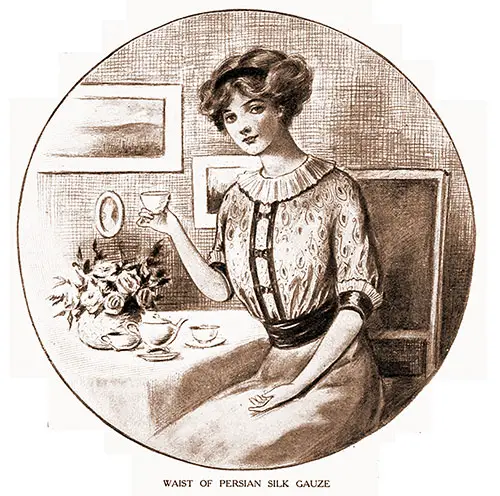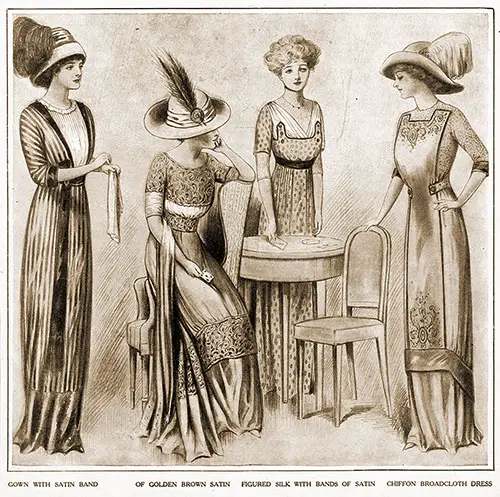Bridge Gowns and Dresses - January 1911

Blouse (Waist) of Persian Silk Gauze. Harper's Bazar, January 1911. GGA Image ID # 1649133f6c
Dainty mazy puzzles and blues with odd touches of red or elusive yellows or greens are blended bewilderingly and really most beautifully in the Eastern prints on silk or cotton. Of these many beautiful bridges, waists are made up this year.
They are usually given a touch of defining satin in plain color; or perhaps a thread of gold in the way of soutache, by which to bring them into harmony with a two-piece costume and so establish the effect of a one-piece dress with a coat.
Such waists are made up more or less in the soft, simple style of the garment shown in the circular illustration on this page. They are nearly always dark in tone, with elusive blues lurking among other shades, suggestive of a peacock's tail-feathers.
Sometimes these Eastern effects are combined in the upper waist and sleeve portions of a gown similar to the last shown in the group below; or a touch of the gauze will be introduced as bretelles similar to those seen in the third gown in the group.

Bridge Gown Designs from Left to Right: Gown with Satin Band; Gown of Golden Brown Satin; Figured Silk Gown with Bands of Satin; and Chiffon Broadcloth Dress. Harper's Bazar, January 1911. GGA Image ID # 1648a915ba
That first dress, of white silk striped with blue velvet, with deep satin skirt band of blue, and white vest, is particularly good, as reflecting the prevailing features of the smart gowns now chosen for luncheon or bridge parties. Simple lines, narrow skirts (some of them still being made up, measure only one and one-half yards around for a thirty-six-inch figure), and flatly trimmed waists, usually with short sleeves, though these may be lengthened with gauze undersleeves, are the features of all such dresses.
Of course, the tendency is away from the much-discussed banded skirt which hobbles the wearer. It is against, too, the extremely narrow skirts described above; but there is a well-founded liking for a skirt which still is narrow, say two yards in width, since it is far easier to manage in disagreeable weather, and warmer than flaring garments, and, when well cut, is becoming to all but the really fleshy woman.
Frocks on the order of the last shown on this page, which has a somewhat full upper skirt portion while it is banded low down toward the foot, are the sort which is being made at the present writing. Other really lovely French models, which will be found among the illustrations on the full page of dresses given elsewhere, will indicate the skirt and waistlines now most approved informal and half-formal dress.
The black or golden brown or amethyst velvet Empire gown is particularly elegant for bridge wear. It is often given a yoke of the cashmere-patterned beaded net and a narrow foot-band of rich fur; or the yoke may be of macramé gold lace over a chiffon foundation.
"Bridge Gowns," in Harper's Bazar, New York-London: Harper & Brothers, Vol. XLV, No. 1, January 1911, p. 32.
